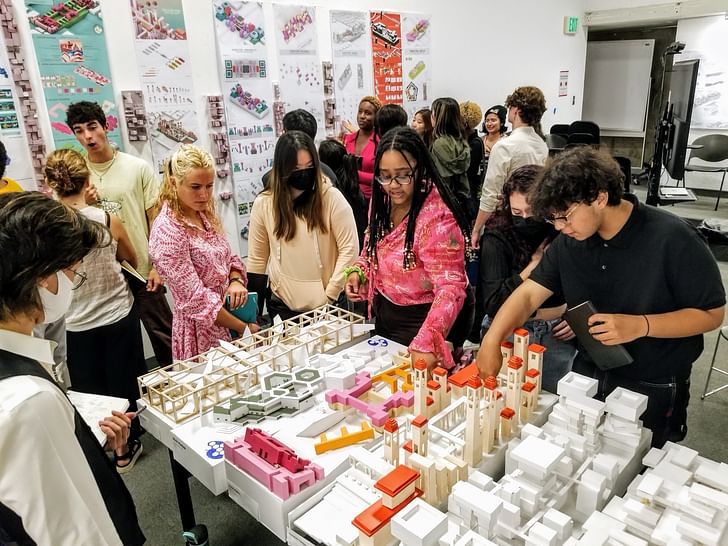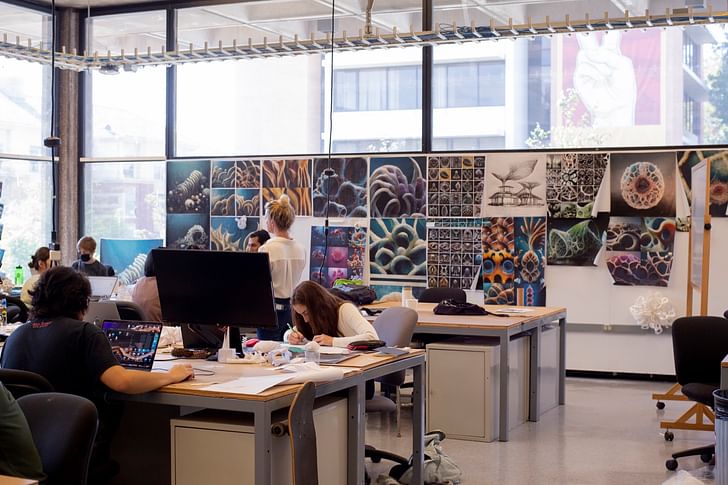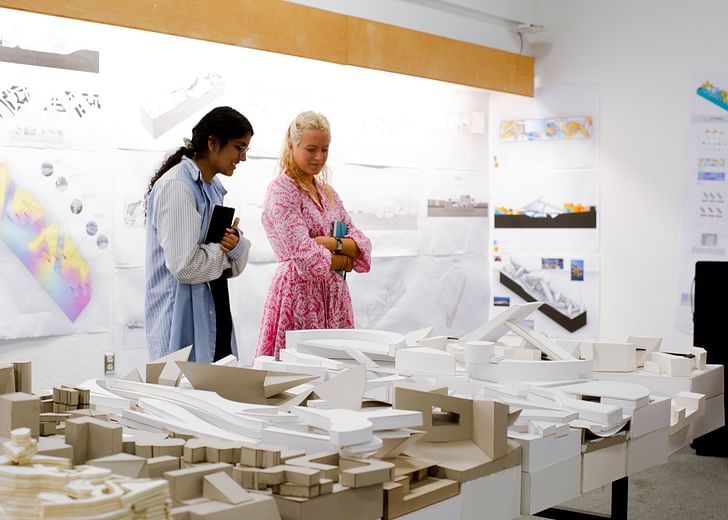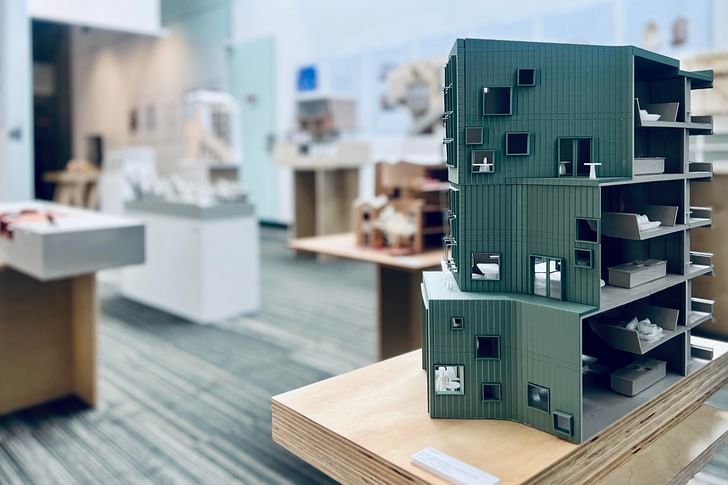

In February 2024, Brett Steele took up the position of Dean of the University of Southern California School of Architecture. Since then, Steele has been busy capitalizing on the opportunities and responsibilities that come with leading a Los Angeles design school in a city known globally for its creativity; a landscape Steele also experienced in his past roles at fellow Los Angeles school UCLA and at the AA in London.
Steele's mission at USC centers not only on preparing students for unpredictable futures but also on "speaking to wider and wider audiences." In that spirit, USC architecture students forge links with their peers in landscape, building science, and beyond, led by a faculty of diverse practitioners. "This isn't a place to just show up for courses; you've got to want to absorb everything around you," Steele notes.
In September 2024, Archinect's Niall Patrick Walsh caught up with Steele as part of our Deans List series to gain an insight into USC Architecture's approach to education, the student experience, and the architecture scene in Los Angeles. The conversation is published below.
Niall Patrick Walsh: You took up the post of USC School of Architecture Dean in February. How are you settling in?
Brett Steele: I kind of hope I’m not settling in so much as just getting on with all the non-stop forms of listening, learning, questioning, and speculating that allow deans to do the kind of work our faculty and staff all do, carrying a school forward. It’s been an honor and privilege, for sure, to come to USC Architecture this year.
The past seven months have raced by in ways that feel more like seven weeks. I chose to come here last spring to benefit from seeing the run-up to the end of an academic year and helped organize us bringing in 80 or so visiting critics from across the U.S. last May to do the same thing I was doing, focusing on the end-of-year projects of our students and studios.
What brought you to USC, and what insights have you taken from your previous experiences, such as UCLA and the AA that you wish to apply at USC?
The key experience from my past roles at the AA in London and UCLA here in Los Angeles translates directly to USC: my awareness of the unique and considerable opportunities — as well as genuine responsibilities — a school located in the absolute heart of a global city has in pushing our fields forward. That has long happened in places like this, and we have to live up to that legacy by leading those efforts again.
Southern California includes the world’s largest creative economy. And architecture, landscape architecture, building heritage, and sciences — USC’s portfolio of academic programs — play important parts in the creative life of that larger creative economy. Which, of course, is, in turn, part of today’s increasingly global forms of knowledge, practice, and discovery.
Educators, including deans, often bring with them unique personal views, interests, and stances on architecture. What are some of the topics and issues related to architecture that you care most about?
I care about the fact that professional lives of all kinds, including architecture, are undergoing historic change. In my view, the field is only broadening. Especially in how architects work, think, and communicate, but also in the kinds of things architects can and should be doing to move the world forward into better forms and spaces than those we know from the end of the last century or early 21st century.
As a school, we’ve got to help our students anticipate, and not only eventually navigate, future lives we can all expect will be very different than those we see today.
As a field, and a profession, we have to get much better at speaking to wider and wider audiences. — Brett Steele
What we now realize is that it’s the knowledge and expertise architects bring to their own work, and that of others, is their greatest asset — design-led ways of thinking and solving problems.
As a field, and a profession, we have to get much better at speaking to wider and wider audiences. I think this is the case for many other professions as well, which have become too insular and risk becoming irrelevant to wider conversations and efforts to create change. Architecture has to be in the mix, and I think we’re uniquely positioned to do that compared to so many other professions and creative fields.
How would you characterize USC’s architecture program? Are there particular themes running through it that differentiate it from other schools?
Our most unique circumstance is one of brilliant geography: We’re in the heart of a great R1 research university full of all kinds of brilliant, top-ranked other professional schools (from engineering, to film, business, or public policy) that, in turn, is in the heart of not just LA but also Southern California. USC’s architecture program has two internal features that differentiate us from many of our peer schools:
Firstly, despite our name, USC Architecture, we’re not a school built around a single subject, so much as a remarkable constellation of 17 certificate- and degree-awarding programs organized across not just ‘architecture’ but also landscape, building science, and historic conservation. Our students see and interact with a broader creative space.
This close connection with rapidly changing professions had been the case here at USC since at least the middle of the last century. — Brett Steele
Our second feature is also a long-held one: Our faculty are practitioners of their respective fields, leading offices of all kinds, doing tons of buildings, landscape, and research projects whose work is brought back to the studios and courses we teach here. This close connection with rapidly changing professions had been the case here at USC since at least the middle of the last century, soon after the school was instrumental in bringing modernism to the U.S. in the 1930s.
In the post-war years, a young Pierre Koenig was here knocking together case study houses. Later, Ralph Knowles’s incredible work invents passive solar architecture as we know it today; Konrad Wachsmann and his students created the unbelievably original three-dimensional structures we all now think of as space frames, which have built so much of the modern world. There are so many others whose work today is opening new forms of practice and not only design.
What type of student thrives at USC?
A student who wants to be in a school in the heart of a global city unlike any other. This is the one-off school that has the features our home city has, with a cultural life that is as sweeping, broad, and continually surprising as is so often the case here in LA.
In just the last couple of months, we’ve had students and faculty doing things all over the city; at the Craft Museum’s just-opened exhibition ‘Material Acts,’ co-curated by our faculty member Kate Yeh Chiu, we will host next month a symposium of participants featuring speakers from Europe and the U.S. Our school faculty and students won design awards at the A+D Museum’s recent annual Design Awards competition, and our students and those of four other schools were in the A+D’s summer show. We had another group of grad students build a 1:1 installation as a new kind of entrance in a cultural center in Korea Town, and a couple of weeks ago, we hosted the Berlin-based artist Olafur Eliasson to launch our fall lecture series.
This isn’t a place to just show up for courses; you’ve got to want to absorb everything around you. — Brett Steele
Last month, USC’s Architectural Guild held its first event with us, part of their year-long work connecting our students to the 1,000 architectural firms here in LA. Tonight, we host an evening lecture by the British architect Sadie Morgan; next week, the emerging LA architect and USC faculty member Lisa Little; and the week after that, the Mexico City-based architect Tatiana Bilbao; on and on.
My point with even this very abbreviated list: Thriving as a student here means being like the school itself and being curious about everything. This isn’t a place to just show up for courses; you’ve got to want to absorb everything around you.
We’re located next to literally dozens of local arts, design, and cultural institutions, museums, and other outposts, and our programs take students to the natural or built landscapes that go from beaches to the nearby valleys, the San Bernadino and the Sierra. Alison Hirsch in our landscape program is working with students in California’s Central Valley in our Landscape Justice Initiative; Alex Robinson’s lab is working on the future of the LA River; and Joon-Ho Choi’s Human-Building Integration Lab is ideally situated here in a city of office spaces, to focus on making healthier indoor places to work. These are all examples of what students are presented with here — to help them find themselves.

Are there any interesting plans or initiatives coming up at USC that you are particularly excited about?
My priorities are about elevating design and critical forms of practice. It’s in our mission, our vision, and, for me, an absolute priority today — as practice itself evolves in so many new and exciting ways.
Here at the school, I believe we have to focus on the architecture of our architecture school: What we call the ‘space’ of that school isn’t a ‘facility’ to manage or a resource to allocate — it’s a medium in which we live, grow, and change. Despite our name, we’re not a single-subject school. Our courses and programs are in architecture, for sure, but also landscape architecture, building science, and historic conservation. Here, those are all gathered together under a single roof in ways that we can take advantage of the distinctly collaborative, cross-disciplinary ways the 21st century is already being worked on. That sensibility is built into our DNA, and we’ve got to leverage that potential.

Given you have served in leading positions at Los Angeles schools over the past decade, what is your view on LA’s architecture culture today?
Architecture and its allied design fields in landscape, urbanism, and related design fields in Los Angeles have definitely seen less disruption than have many other sectors of our local creative economy (think of what AI is already doing to Hollywood writers’ rooms, or what the arrival of franchise galleries are doing to the local art market). But like every other aspect of modern and professional life, change is surely coming to our field, the way architects work, and most especially for us, the way architects teach and learn. We’ve got to embrace, prepare for, and push back on parts of that reality.
Change is surely coming to our field, the way architects work, and most especially for us, the way architects teach and learn. — Brett Steele
There are plenty of signs of a burgeoning local LA culture around architecture and design here for sure — just look at the arrays of shows and exhibitions in local museums. Architecture is all over this fall’s Getty-sponsored ‘Art & Science’ theme of this year’s Pacific Standard Time. There are new publications focusing on architectural life in LA, like Thom Mayne’s just-released ‘Of the Moment’ featuring dozens of local contributors, writers, and critics, or last summer’s ‘Issue One’ of the New York Review of Architecture issue on LA.
There are lively and active public programs related to architecture not just at our school but the other great schools here in LA and Southern California. And in the last few years, universities from places as diverse as Arizona or even New York have pitched up here to open LA buildings associated with architecture, design, and the arts — even the AIA has a new and lively cultural space of its own here near USC. There’s a lot happening, and we’re a model of what any city should be doing.

What are some of the most significant challenges facing architectural education today in your view?
I take the single greatest challenge facing architectural education to be its associated professions’ own forms of inertia. The slow-moving, largely conservative (not just conserving) habits, routines, and assumptions of our professionalized field. It’s hard for architecture to keep up with the kinds of changes all around us. It needs to do that, become more diverse, embrace its inherent potential for a broadened impact on society, and be more open to alternative ways of working, thinking, and delivering what architects do — and are able to do.
In so many ways, architecture is incredibly slow-moving, exclusionary, and increasingly unable to navigate shifts in the tectonic plates upon which modern architecture was assembled. The world is just moving too fast for architecture to keep up sometimes. And in a global economy that now places real value on the production of knowledge and information, more than things associated with bricks and mortar, this is a seismic change for architecture. We’ve long presumed our role to be the one-off design and construction of physical ‘stuff’ more than what we now realize is where our real value lies: In our capacity to form new ideas, expertise, or knowledge of the built world around us.

As we begin a new academic year, what advice do you give to both educators and students?
Embrace optimism. It’s 2024, that’s a hard project, for sure. But hey — arguably, optimism is more important than ever. The future is becoming a project again, and one thing architects are good at: looking forward. It’s literally built into the jobs we do, changing the world one project at a time.
I think the biggest thing we can do is embrace our world’s need for change. By doing that, we can change schools, like offices, and our wider professions. And along the way, design not just projects but the kinds of urgency ultimately needed for those larger projects to live.
Niall Patrick Walsh is an architect and journalist, living in Belfast, Ireland. He writes feature articles for Archinect and leads the Archinect In-Depth series. He is also a licensed architect in the UK and Ireland, having previously worked at BDP, one of the largest design + ...
11 Comments
Is it reactionary to expect the work of students to resemble the kind of work they will be doing after graduation?
Just my opinion:
In addition to the typical architectural education:
Have at least one class on detailing / drafting.
Have one studio be a design build OR function as a practicing office. Small / simple projects, have changes, pay apps, ect.
Embrace Optimism. What does that mean in terms of approach? Do you wait or engage yourself in being a advocate for the role of architecture or be a leader in re-imaging communities?
Architecture schools are behind the curve in engaging themselves in communities in the challenges and complexities of a uncertain world. Especially in LA, where Mayor Bass declared the 28' Olympics to be car-free, city planning is updating their community plans and a new zoning code that is form-based. Addressing density, housing, urban scale, sustainability, design & art, Infrastructure, open space and identity are essential.
Architecture cannot change social shortcomings and disparities. In the end any architecture that could assist in rectifying these situations cost money. That money comes from somewhere. Unfortunately, those with the money are the ones who decide what issues are addressed and how.
Here's what architecture can do, courtesy of Buffalo NY
what did architecture do in these examples?
Make my day a little better and I'm assuming others who have similar visual and emotional wiring
I’m wet. Or is it
moist?
Ah I see.
i was asking sincerely, no snark. The architecture is nice but is not doing anything other than looking good. As opposed to other equally old-timey buildings that engage with the street and create a neighborhood vibe. I live in a 19th century Victorian house in Toronto with a porch and balcony and a wild landscaped yard that engages the street. The form creates a literal social gathering place for others in the building. It is actually doing something, with cause and affect and everything.
My home in Japan does a completely different thing, because it is a farm house, but it is also very much a building that motivates action. The examples you show are not as obviously doing any of that. But maybe I am not seeing what you are. Hence my question. Again no snark intended.
No snark perceived, but I've been known to miss social clues. Other things those buildings do is give locals pride of place and a sense of identity in an increasingly commercialized and anonymous world as the mural attests to. They also embody carbon yada yada by being resilient to the elements, given minimal maintenance. The truth is this quality is so subjective as to be impossible to quantify even though we know it affects people emotionally. I think this is another reason the modern built environment (in general!) is so soul sucking compared to these old pile of bricks. Those architects wanted to make people on the street smile and improve their day, something we all feel when surrounded by an environment that was designed to appeal to our visual and emotional nature.
i can agree with that point of view, whole heartedly.
North America cities are not being built in the nicest way right now. Lots of dead streetscapes and car-dominated planning in general that does not compare well with what we did in the past - ironically, when we had far less means and methods at our disposal.
By comparison my home in Tokyo is a flat concrete box covered with grey tile, and it is easily more homey and comfortable - and engaged with the street - than most of the condos i see in Toronto (and Paris too for that matter). Based on my experience only, I find myself becoming less interested in the beauty of architecture and more in how it engages with the street and the community in general. Big plinth buildings with towers plonked on them were supposed to save the streets but it does not work in practice and we end up with large blank facades with retail giants parked behind them and no give and take with the street at all.
Tokyo is more like Sim's Soft City concept. Except the buildings are mostly ugly in all honesty. Nothing like the examples you show above. But the vibe is pure human and it is extremely nice to live there.
Joy at being next to beauty is worth doing more of. I am more impressed when the beauty is also connected to the building of a local street life. That can be ugly AF and still be amazing as a human experience.
Somehow we seem incapable of that kind of outcome with our current planning laws and economy. It is not a good time for our cities, in spite of all the money pouring into them right now.
Block this user
Are you sure you want to block this user and hide all related comments throughout the site?
Archinect
This is your first comment on Archinect. Your comment will be visible once approved.